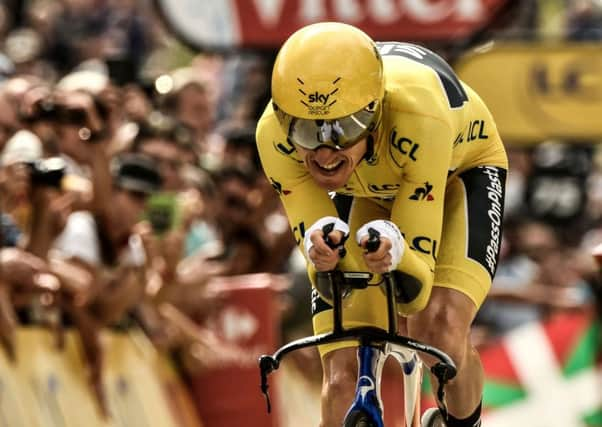This year’s Tour de France is as clear as mud


It would also, said Prudhomme, be “the highest Tour in history”.
When the race gets under way next Saturday in Brussels, where Merckx spent his childhood, it isn’t 1919 or 1969 that will be evoked, but 2006, or 1997, or perhaps 1987. These were Tours that followed a dynasty – Lance Armstrong in 2006, Miguel Indurain in ’97, Bernard Hinault in ’87 – and which began without a clear favourite.
Advertisement
Hide AdAdvertisement
Hide AdThis time it is Chris Froome who is missing. The four-time winner, who until a couple of weeks ago was set to start as favourite, had a freak crash while warming up for the time trial at the Critérium du Dauphiné.
Taking his hand from the bars to clear his nose, Froome’s front wheel was caught by a gust of wind, slamming him against a wall at high speed. The injuries were as if he had fallen from a plane: broken femur, hip, elbow, several ribs and a bone in his neck. The 34-year-old is not expected to race again this season.
It appeared to answer one question: would Geraint Thomas, who won last year, with Froome third a few weeks after winning the Giro d’Italia, be allowed to mount a serious defence? Most assumed Thomas would have to ride in support of Froome at Team Ineos, as Team Sky has become. Froome’s crash obviously changed that.
But then, a week later, Thomas crashed out of the Tour of Switzerland. Sitting on the road looking dazed, with a doctor anxiously checking his collarbone, it seemed that Team Ineos was cursed. But although Thomas was out of the race, he was not out of the Tour.
And so it seems clear: Thomas will start with No.1 on his back as defending champion and, in the absence of so many other contenders, a decent bet to win again.
Well, maybe. It’s about as clear as mud, for two reasons. One is Thomas’s less than perfect buildup: he resumed training a little later than usual; he crashed out of Tirreno-Adriatico in the spring; a high-altitude training camp in Tenerife was cut short because of snow; then there was the crash in Switzerland.
The second reason is Egan Bernal. The young Colombian was supposed to lead Team Ineos at the Giro in May but – guess what – he crashed in training, breaking his collarbone. He returned at the Tour of Switzerland and won, perhaps not as emphatically as some expected, but he certainly showed enough to suggest that he will be a factor at the Tour. Whether that is in support of Thomas, or in pursuit of his own ambitions, could be decided not in team meetings but on the road.
Which is where Prudhomme’s boast of the “highest ever Tour” becomes interesting. There are three mountain top finishes higher than 2,000 metres and also an ascent of the Col d’Iseran, which at 2,770m is the highest paved road in Europe. The penultimate stage ends with the 33km climb to 2,365m at Val Thorens.
Advertisement
Hide AdAdvertisement
Hide AdBernal, who grew up at 2,600m altitude in Bogota, is a tremendously gifted climber and will relish this. After winning in Switzerland he played down talk of him being favourite for the Tour, saying that Thomas “will be our leader” and that “if he’s better than me, for sure I will help him”. The qualifier was significant.
Announcing their eight riders on Friday, Team Ineos cleared things up: Thomas and Bernal will be joint leaders. “Discussing it with the team, we believe it makes sense to go into the race with joint leaders as it gives us more options,” said Thomas.
“Joint leadership” is a misnomer: it means deferring a decision, because, in the end, only one rider can win.
Another team with two potential leaders is the Australian squad Mitchelton-Scott with the British twins, Adam and Simon Yates. The Tour has been Adam’s focus all year, and he has had an almost perfect build-up. The Giro was Simon’s priority, and it didn’t go well: the winner of last year’s Tour of Spain was at a loss to explain why he was never in contention in Italy.
It is possible that Simon will find his legs in France, but more likely that Adam, who was fourth in 2016, will be the rider challenging for the podium, or even the win.
What of the others? There’s Nairo Quintana, the in-form Dane Jakob Fuglsang, the 2014 winner Vincenzo Nibali, and the French. “It’s now or never,” said the front page of L’Equipe this week, referring to the quest for a first home win since Hinault’s fifth in 1985. Thibaut Pinot and Romain Bardet, both podium finishers in the past, are the obvious picks, but it is difficult to see either winning.
Then again, in this most open of Tours, it is difficult to see anyone winning. Will it be like 1987, when the shrewd and experienced Stephen Roche triumphed, or 1997, when a young rider, Jan Ullrich, bulldozed the opposition? Prudhomme will have only one hope: that it isn’t like 2006.